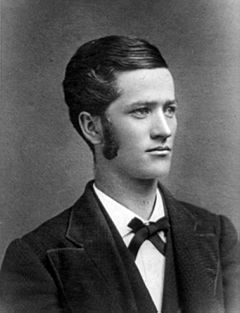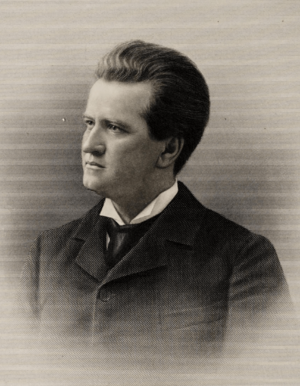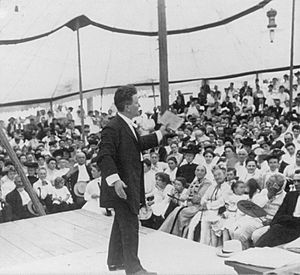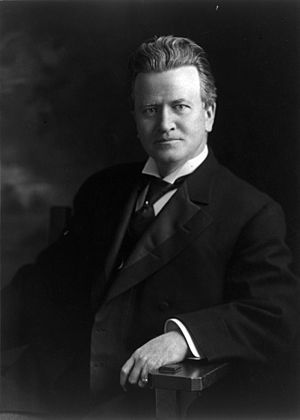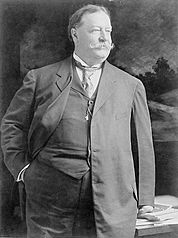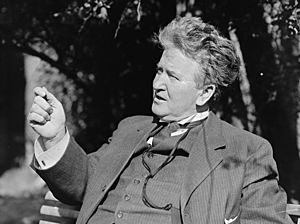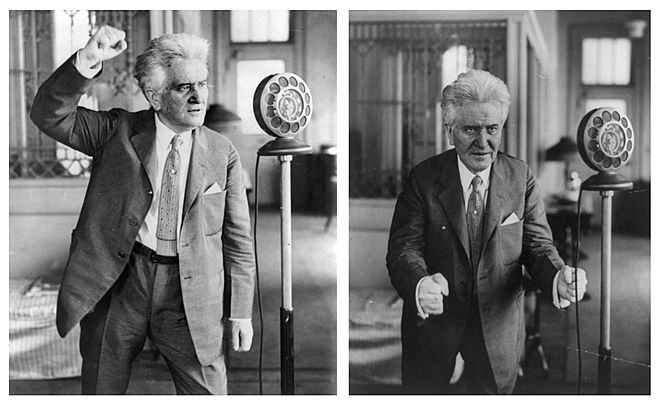Robert M. La Follette facts for kids
Quick facts for kids
Robert La Follette
|
|
|---|---|
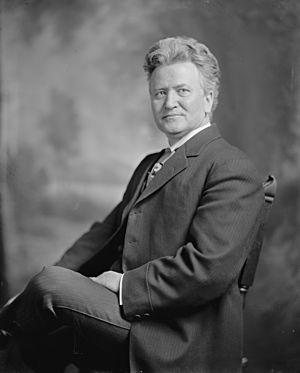 |
|
| United States Senator from Wisconsin |
|
| In office January 4, 1906 – June 18, 1925 |
|
| Preceded by | Joseph V. Quarles |
| Succeeded by | Robert M. La Follette Jr. |
| 20th Governor of Wisconsin | |
| In office January 7, 1901 – January 1, 1906 |
|
| Lieutenant |
|
| Preceded by | Edward Scofield |
| Succeeded by | James O. Davidson |
| Member of the U.S. House of Representatives from Wisconsin's 3rd district |
|
| In office March 4, 1885 – March 3, 1891 |
|
| Preceded by | Burr W. Jones |
| Succeeded by | Allen R. Bushnell |
| Personal details | |
| Born |
Robert Marion La Follette
June 14, 1855 Primrose, Wisconsin, U.S. |
| Died | June 18, 1925 (aged 70) Washington, D.C., U.S. |
| Resting place | Forest Hill Cemetery |
| Political party | Republican |
| Other political affiliations |
Progressive (1924) |
| Spouse | Belle Case |
| Children | 4, including Robert Jr., Philip, and Fola |
| Education | University of Wisconsin–Madison (BS) |
| Signature | |
Robert Marion La Follette Sr. (June 14, 1855 – June 18, 1925) was an American lawyer and politician. People often called him "Fighting Bob" because he fought for his beliefs. He represented Wisconsin in the House of Representatives and the Senate. He also served as the Governor of Wisconsin from 1901 to 1906.
La Follette was a Republican for most of his life. However, he ran for President of the United States in 1924 with his own Progressive Party. Many historians say he is the most famous person in Wisconsin's history.
Born and raised in Wisconsin, La Follette became the district attorney for Dane County, Wisconsin in 1880. Four years later, he was elected to the House of Representatives. After losing his seat in 1890, La Follette became a strong supporter of progressivism. He worked to bring together Republicans who wanted change. He ran for governor several times before winning in 1900. As governor, he brought in new ideas like primary elections and fairer taxes.
La Follette was re-elected governor in 1902 and 1904. In 1905, he was elected to the U.S. Senate. There, he became a national leader for progressive ideas. He often disagreed with conservative politicians. He even challenged President William Howard Taft for the Republican presidential nomination in 1912. During World War I, La Follette was one of the few who spoke out against the war.
In the 1924 presidential election, La Follette ran as a third-party candidate. He had support from groups like the Socialist Party, farmers, and labor unions. He wanted to stop big companies from having too much power. He called for the government to own railroads and electric companies. He also wanted to outlaw child labor and help labor unions. Even though he didn't win, he got 16.6% of the popular vote. This was one of the best results for a third party in U.S. history. La Follette died shortly after the election. His sons, Robert M. La Follette Jr. and Philip La Follette, continued his work as progressive leaders.
Contents
Early Life and Education
Robert Marion La Follette Sr. was born on a farm in Primrose, Wisconsin, on June 14, 1855. He was the youngest of five children. His parents, Josiah La Follette and Mary Ferguson, moved to Wisconsin in 1850. Josiah died when Robert was only eight months old. In 1862, his mother married John Saxton. Robert did not get along well with Saxton.
La Follette started school at age four, but he also worked on the family farm. After Saxton died in 1872, Robert, his mother, and sister moved to Madison. La Follette started attending the University of Wisconsin in 1875. He graduated in 1879 with a science degree. He was not the best student, but he won a speech contest. He also started a student newspaper called the University Press.
The university's president, John Bascom, greatly influenced La Follette. Bascom taught him about right and wrong, and about fairness in society. During college, La Follette became a vegetarian. He believed it gave him more energy and a "clear head."
La Follette met Belle Case at the University of Wisconsin. They married on December 31, 1881. Belle became a leader in the feminist movement. She supported suffrage (the right to vote) for women. She also greatly influenced La Follette's ideas.
Early Political Career
Serving in the House of Representatives
La Follette became a lawyer in 1880. That same year, he was elected as the district attorney for Dane County, Wisconsin. This was the start of his long political career. In 1884, he was elected to the House of Representatives. He was the youngest member of Congress at that time. His political ideas were similar to other Republicans in the North. He supported high tariffs, which are taxes on imported goods. He also became friends with party leaders like William McKinley.
Sometimes, he disagreed with party leaders. He voted for laws to regulate railroads and stop monopolies. He also spoke out against unfair treatment of African Americans in the Southern United States. He supported a bill that would protect Black Americans' right to vote. A newspaper called him "so good a fellow that even his enemies like him."
In 1890, La Follette lost his seat in Congress. This was partly because of a law passed in Wisconsin that required schools to teach major subjects in English. This law caused problems between Catholic and Lutheran communities. His support for high tariffs might have also played a role. After losing, La Follette returned to Madison to practice law. Because of his strong personality, he became known as "Fighting Bob" La Follette.
Running for Governor
In 1891, La Follette said that Senator Philetus Sawyer tried to bribe him. La Follette claimed Sawyer offered him money to influence a court case. This case involved state money that Republican officials had supposedly stolen. La Follette's public accusation caused a break with many of his friends and party leaders.
Instead of leaving politics, La Follette started building a group of unhappy Republicans. Many of them were young and educated. He worked with people like former governor William D. Hoard. His group also included many people from the state's large Scandinavian population.
From 1894, La Follette's group tried to win the office of Governor of Wisconsin. La Follette ran for governor in 1896 and 1898 but lost in the Republican primary elections. He claimed that conservative party leaders cheated to win. In 1897, La Follette began to push for primary elections. This would let voters choose party candidates directly, instead of party leaders. He also said that big companies had too much power over the Republican Party. These progressive ideas became popular after a bad economic time in 1893.
In 1900, La Follette ran for governor a third time. He won the Republican nomination and then easily defeated his Democratic opponent. He won almost 60 percent of the vote.
Governor of Wisconsin (1901–1906)
When La Follette became governor, he wanted to make many changes. His main goals were to start primary elections and change the state's tax system. He hoped to work with other Republicans, but conservatives and railroad companies opposed him. La Follette vetoed a bill that would only allow primary elections for local races. The state Senate criticized him for attacking them over his tax bill.
Conservative party leaders tried to stop La Follette from being re-nominated in 1902. But La Follette's supporters were strong and took control of the state convention. They created a progressive party plan. In the 1902 election, La Follette easily won against his Democratic opponent.
After the 1902 election, the state legislature passed the direct primary law. They also passed La Follette's tax reform bill. The new tax law made railroads pay almost double the taxes they paid before. La Follette then focused on controlling railroad prices. He also believed that a direct income tax was needed to stop rich people from avoiding taxes. During his time as governor, La Follette appointed William Miller, an African American, to a position in his office.
In 1903, La Follette started giving speeches across the Midwest. He gained attention from journalists who supported his progressive ideas. Many Republican leaders did not like La Follette's progressive direction. In 1904, La Follette's supporters and conservative leaders held separate meetings. The state Supreme Court decided that La Follette was the official Republican candidate for governor. He won the election with 51 percent of the vote. In that same election, Wisconsin voters approved the direct primary system.
La Follette had promised not to resign as governor during his term. However, after winning re-election, he worked to be elected to the United States Senate. At that time, state legislatures elected senators. La Follette was chosen by the Republican group on January 23, 1905. He delayed accepting the nomination and stayed as governor until December 1905. He continued to push for progressive policies, like regulating railroad rates. He signed a law for railroad regulation, even though he thought it was too weak. Lieutenant Governor James O. Davidson took over as governor.
Senator (1906–1925)
Working with President Roosevelt
La Follette quickly became a progressive leader in the Senate. He focused on a railroad regulation bill. He said the bill, called the Hepburn Act, was not strong enough. He also traveled the country, encouraging voters to elect progressive senators. Conservative leaders did not like La Follette. They gave him unimportant committee jobs to try and limit his power. Still, La Follette found ways to fight against powerful coal companies. He pushed for more power to regulate railroads.
With help from friendly journalists, La Follette helped pass the 1907 Railway Hours Act. This law stopped railroad workers from working more than 16 hours in a row. La Follette initially got along well with President Theodore Roosevelt. But he became disappointed when Roosevelt did not support some progressive ideas.
After the Panic of 1907 (a financial crisis), La Follette strongly opposed a bill that would allow more money to be printed. He claimed that the crisis was caused by a "Money Trust" of large companies. He believed they wanted to hurt smaller businesses and force the government to help them. La Follette could not stop the bill from passing. But his 19-hour speech, the longest in Senate history at that time, became very popular.
Challenging President Taft
Starting in 1908, La Follette tried to become president. He hoped that famous journalists would help him get the Republican nomination. But he did not have much support outside of Wisconsin. At the 1908 Republican convention, most Wisconsin delegates supported him. However, no other states did. William Howard Taft won the nomination. La Follette was happy that the party wanted to lower tariffs. Taft won the 1908 election. In early 1909, La Follette started La Follette's Weekly Magazine, which became very popular.
La Follette led a group of progressive Republicans in the Senate. They argued with conservative leaders about lowering tariffs. They wanted to lower prices for consumers. They believed that high tariffs unfairly protected big companies, allowing them to charge high prices. Despite calls for lower tariffs, a new law, the Payne–Aldrich Tariff Act, kept tariffs high. President Taft supported it. La Follette's group was the only Republican senators to vote against it. However, the progressives did start the process for the Sixteenth Amendment, which allowed the federal government to collect an income tax.
In 1909, Taft fired an official who said that the Secretary of the Interior was illegally expanding coal mining. This led to a big argument between Taft's administration and Gifford Pinchot, a friend of Theodore Roosevelt. La Follette's progressives criticized Taft and started a congressional investigation.
In 1911, La Follette was re-elected to the Senate. This made him an even stronger leader of the progressive Republicans. In January 1911, La Follette started the National Progressive Republican League. This group wanted to pass progressive laws like direct primary elections and the direct election of U.S. senators. La Follette hoped this group would help him challenge Taft for the 1912 Republican presidential nomination. Many progressive leaders joined the league, but Theodore Roosevelt did not. Roosevelt thought the group was too extreme.
By mid-1911, most progressives thought the 1912 election would be between La Follette and Taft. But La Follette worried that Roosevelt would enter the race. Many progressive leaders criticized La Follette for writing his autobiography instead of campaigning. La Follette believed his book would help him win votes. Roosevelt announced his candidacy in early 1912. La Follette refused to drop out and support Roosevelt.
In February 1912, La Follette gave a very bad speech in Philadelphia. He spoke for two hours to a large group of magazine editors and writers. Many in the audience thought he was having a mental breakdown. Most of his supporters then switched to Roosevelt. La Follette's family said he was upset because his daughter needed surgery. She recovered, but his campaign did not. Still, La Follette kept campaigning, focusing his attacks on Roosevelt.
La Follette hoped to win in the 1912 Republican primaries. But he only won in Wisconsin and North Dakota. He continued to oppose Roosevelt at the 1912 Republican National Convention. Taft was re-nominated. Roosevelt's supporters left the Republican Party and formed the Progressive Party. They nominated Roosevelt. La Follette continued to call Roosevelt a "traitor" to the progressive cause. He stayed neutral in the election between Roosevelt, Taft, and the Democratic candidate, Woodrow Wilson. Wilson won the election because the Republican Party was split. La Follette's actions during the campaign hurt his standing as a progressive leader in the Senate. Many progressives felt he had harmed their cause by not working with Roosevelt.
During the Wilson Administration
La Follette hoped to work with President Wilson. But Wilson chose to rely on Democrats in Congress. Still, La Follette was the only Republican senator to vote for the Revenue Act of 1913. This law lowered tariffs and created a federal income tax. La Follette wanted the income tax to help share wealth more fairly. He pushed for a higher tax on very rich people. La Follette also disagreed with Wilson's plan for the Federal Reserve Act. He thought it was too friendly to banks.
In 1915, La Follette helped pass the Seamen's Act. This law allowed sailors to quit their jobs at any port where cargo was unloaded. It also required passenger ships to have enough lifeboats.
In 1914, La Follette and his progressive allies in Wisconsin faced a big defeat. A conservative railroad executive was elected governor. La Follette won re-election to the Senate in 1916. By 1916, foreign policy was a major issue. La Follette strongly opposed American military actions in Latin America. When World War I started in 1914, La Follette praised Wilson's policy of staying neutral. But he disagreed with Wilson as the president started favoring the Allied Powers.
La Follette opposed the United States entering World War I. On April 4, 1917, the day Congress voted on war, La Follette strongly spoke against it in the Senate. The Senate voted 82–6 to support entering the war. The House of Representatives voted 373–50 two days later. La Follette faced immediate criticism. A newspaper said he was acting for German interests and was "un-American." After the U.S. declared war, La Follette criticized many of the government's wartime policies. This included the draft and laws that limited free speech. Many Americans thought La Follette was a traitor.
After the Russian Revolution in late 1917, La Follette supported the Bolsheviks. He believed they were trying to create a fairer society. He criticized the Allied intervention in the Russian Civil War in 1919. He thought Wilson wanted to stop socialism from spreading. During the First Red Scare (a time of fear about socialism), La Follette spoke out against government raids. He wanted to repeal laws that limited free speech. He also helped stop the U.S. from joining the League of Nations. La Follette believed the League was mainly designed to protect the financial interests of the U.S. and its allies.
During the Harding and Coolidge Administrations
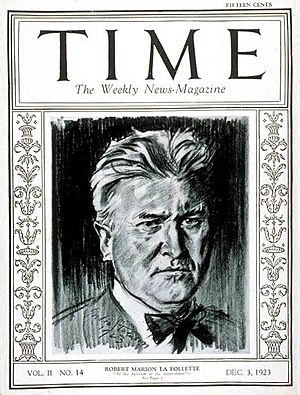
La Follette still had influence in Wisconsin after the war. He led a progressive group to the 1920 Republican National Convention. But across the country, the Republican Party was becoming more conservative. La Follette was called a "Bolshevik" when he asked to cancel a railroad law. After the Republican Party nominated conservative senator Warren G. Harding, La Follette thought about running for president as a third-party candidate. But different progressive groups could not agree on a plan.
After Harding won the 1920 election, La Follette joined a group of congressmen called the "farm bloc." They wanted federal loans for farmers and lower tariffs. He also opposed tax cuts proposed by the Treasury Secretary. His opposition helped prevent Congress from cutting taxes as much as planned.
In 1922, La Follette easily won re-election to the Senate. Many conservative Republicans lost their elections that year. This gave La Follette and his allies more power in Congress. When the Supreme Court struck down a federal child labor law, La Follette became very critical of the Court. He suggested an amendment that would let Congress re-pass any law the Court declared unconstitutional. La Follette also started investigations into the Harding administration. His efforts helped uncover the Teapot Dome scandal. Harding died in August 1923. Vice President Calvin Coolidge, a conservative Republican, became president.
In 1920–21, La Follette continued to support the Bolsheviks in Russia. He also spoke out against imperialism and militarism. He opposed the peace treaty after World War I and still rejected the League of Nations. He supported self-government for Ireland, India, and Egypt. He wanted foreign interests to leave China. By 1922, he mainly focused on issues within the United States.
1924 Presidential Campaign
By 1924, conservative ideas were strong in both major parties. In 1923, La Follette started planning to run for president as a third-party candidate. He sent his supporters to different states to build support. In early 1924, labor unions, socialists, and farm groups formed the Conference for Progressive Political Action (CPPA). This group brought together many left-wing organizations. It included groups for African Americans, women, and college voters. The CPPA planned a meeting to nominate a presidential candidate in July 1924.
La Follette had changed his views on the Bolsheviks after visiting the Soviet Union in late 1923. He saw how Communism affected civil liberties and political rights. He also visited England, Germany, and Italy. He was upset by the lack of freedom of the press under leaders like Benito Mussolini. With other left-wing groups supporting La Follette, the Communist Party nominated its first presidential candidate.
On July 3, 1924, La Follette announced he would run for president. He said his main goal was "to break the combined power of the private monopoly system over the political and economic life of the American people." The CPPA meeting quickly supported his presidential bid. La Follette's first choice for his running mate, Supreme Court Justice Louis Brandeis, refused. The convention then nominated Senator Burton K. Wheeler of Montana. Wheeler was a progressive Democrat who did not support the Democratic nominee. La Follette did not want the CPPA to form a full third party or run candidates for other offices. La Follette appeared on the ballot in almost every state. His ticket was called by different names, like "Progressive" or "Socialist."
After the convention, the Socialist Party of America supported La Follette. The American Federation of Labor and many other worker groups also supported him. Famous people like activist Margaret Sanger and African-American leader W. E. B. Du Bois also endorsed La Follette.
La Follette's platform was based on ideas he had supported for years. He wanted the government to own railroads and electric companies. He called for cheap loans for farmers and to outlaw child labor. He also wanted stronger laws to help labor unions and more protection for civil liberties. He wanted to end American imperialism in Latin America. He also wanted a referendum (a direct vote by the people) before any president could lead the nation into war again.
At first, some thought La Follette might win enough votes to force the election to be decided by the House of Representatives. But as election day got closer, hopes for a La Follette victory faded. The groups supporting La Follette often disagreed. His campaign also did not have as much money as the other candidates. Big company leaders saw La Follette as a threat. They campaigned against him. Republicans argued that electing La Follette would hurt the economy. They focused their attacks on La Follette, not the Democratic candidate. In August and September, La Follette spoke out against the Ku Klux Klan. He also opposed immigration limits based on race.
In the end, La Follette received 16.6 percent of the vote. Calvin Coolidge won the election. La Follette won his home state of Wisconsin. He finished second in eleven other states, mostly in the West. He did best in rural areas and working-class cities. Much of his support came from people linked to the Socialist Party. La Follette's 16.6 percent is the third best popular vote showing for a third party since the American Civil War. The CPPA broke up shortly after the election.
Death and Legacy
La Follette died in Washington, D.C., on June 18, 1925. He was 70 years old, and died from heart disease, complicated by bronchitis and pneumonia. He was buried in the Forest Hill Cemetery in Madison, Wisconsin. After his death, his wife, Belle Case La Follette, was offered his Senate seat, but she declined. His son, Robert M. La Follette Jr., was then elected senator from Wisconsin.
After her husband's death, Belle Case remained an important figure. By the mid-1930s, the La Follette family had reformed the Progressive Party in Wisconsin. This party quickly became very powerful in the state. Their younger son, Philip La Follette, was elected Governor of Wisconsin. Their older son, Robert M. La Follette Jr., took over his father's Senate seat. La Follette's daughter, Fola La Follette, was a well-known supporter of women's right to vote and a labor activist.
La Follette has influenced many other progressive politicians. In 1957, a Senate Committee chose La Follette as one of five senators to be in the Senate "hall of fame." In 1982, a survey of historians ranked La Follette as one of the "ten greatest Senators in the nation's history." Historian John D. Buenker called La Follette "the most celebrated figure in Wisconsin history." One of Wisconsin's two statues in the National Statuary Hall is of Robert M. La Follette Sr. His house in Maple Bluff, Wisconsin, is a National Historic Landmark. Other things named after La Follette include La Follette High School in Madison and the town of La Follette, Wisconsin.
The Fighting Bob Festival is an event held every September by Wisconsin progressives. It was started in 2001. The festival has been held in different cities in Wisconsin. Many important political figures and journalists have spoken at the festival.
Images for kids
See also
 In Spanish: Robert M. La Follette para niños
In Spanish: Robert M. La Follette para niños
- History of Wisconsin
- La Follette family
- The Rhetorical Presidency


